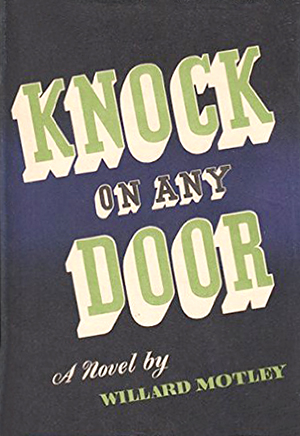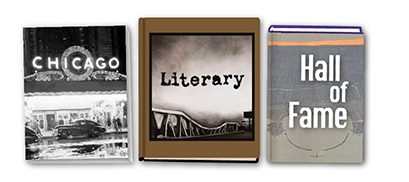
Willard Motley’s Knock on Any Door
Wednesday, April 2, 2025
by Dmitry Samarov
Willard Motley (June 14, 1909–March 4, 1965) used to be read by many. He grew up in a middle-class African-American household in the then primarily-white neighborhood of Englewood in Chicago. The prominent painter Archibald Motley was his uncle, cousin, or brother (according to various sources).

He first gained notice when he submitted a short story to the Chicago Defender at the age of 13. This led to his being hired to write a children’s column under the penname “Bud Billiken” from 1922 to 1924. (“Bud Billiken” was later used for a South Side Chicago parade which continues to this day.)
Motley’s most popular novel, Knock on any Door, sold 47,000 copies in its first three weeks of release. Its hero Nick Romano famously said, “Live fast, die young, and have a good-looking corpse.” The book was adapted into a 1949 film directed by Nicholas Ray and starring Humphrey Bogart.
Phoebe Lou Adams, writing for the July 1947 issue of The Atlantic, calls Knock on Any Door, “a truly remarkable first novel. Soberly, conscientiously, Mr. Motley documents the development of a criminal. It would be more accurate, perhaps, to say the development of a boy who is executed for shooting a policeman, for Nick has little conscious desire to be a criminal, and less talent for it. The background of Nick’s tragedy is built up out of small bits and scenes which gradually knit together into an almost unbearably convincing picture of slum life.”
Motley’s novel received a lot of attention around the time of its publication date of May 5, 1947. George J. Becker, focusing on its naturalistic elements in Commentary, described the novel as “a powerful, and for the most part honest, representation of experience; it is at times a terrifying and beautiful book.” Just before its publication date, Kirkus Reviews wrote, “This is the most obsessive book I've read since- perhaps, Strange Fruit. It is the sort of book one would like to ignore, to forget, because it indicts every member of society in such fearless terms, while offering no specific for the ills it presents.” Charles Lee, writing in The New York Times on May 4, 1947, wrote, “LET it be stated at once: an extraordinary and powerful new naturalistic talent herewith makes its debut in American letters.” Walter J. Kendall, in a 1989 essay for Law and Politics Book Review, examined it from a different angle, writing, “KNOCK ON ANY DOOR presents in stark detail a picture of both early twentieth century sociological theory and the pre-Warren Court criminal justice system. The first 343 pages can readily be used as a case study against which to analyze and critique contemporary sociological, psychological, and philosophical views of the relationship between environment and criminal behavior in its many permutations, especially juvenile justice.”
detail a picture of both early twentieth century sociological theory and the pre-Warren Court criminal justice system. The first 343 pages can readily be used as a case study against which to analyze and critique contemporary sociological, psychological, and philosophical views of the relationship between environment and criminal behavior in its many permutations, especially juvenile justice.”
As a testament to its lasting value, Knock on Any Door has sold more than 10 million copies.
Motley was a co-founder of Hull-House Magazine, which published some of his first adult writings.
From Motley’s “Pavement Portraits,” The Hull-House Magazine, Dec. 1939:
I. THE STREET
This is the corner. Here is where the women stand at night. This is where the evangelists preach God on Sundays. Here is where knife-play has written a moment’s strange drama; where sweethearts have met; where drunks have tilted bottles; where shoppers have bargained; where men have come looking — for something… This is the humpty-dumpty neighborhood. Maxwell and Newberry…
Here is where the daytime pavement never gets a rest from the shuffle of feet. Where the night-time street lamps lean drunkenly and are an easy target for the youngsters’ rocks. Where garbage cans are pressed full and running over. Where the weary buildings kneel to the street and the cats fight their fights under the tall, knock-kneed legs of the pushcarts. This is the down-to-earth world, the bread and beans world, the tenement-bleak world of poverty and hunger. The world of skipped meals; of skimp pocketbooks; of nonexistent security — shadowed by the miserable little houses that Jane Addams knew. Maxwell and Newberry…
This is the street of noises, of odors, of colors. This is a small hub around which a little world revolves. The spokes shoot off into all countries. This is Jerusalem. The journey to Africa is only one block; from Africa to Mexico one block; from Mexico to Italy two blocks; from Italy to Greece three blocks…
This is the pavement. These are the streets. Here are the people…
Responding to criticism that he did not directly address race in his work, Motley said, “My race is the human race.”
Motley died of intestinal gangrene in Mexico City in 1965, poor and forgotten. His papers are held at the Chicago Public Library and Northern Illinois University.
My friend, Bill Savage, owns a copy of Nelson Algren’s Neon Wilderness inscribed by the author as “the poor man’s Willard Motley.”
Dmitry Samarov paints and writes in Chicago. He is the author of six books, including his memoirs Hack and Where To? about his experiences driving a cab in Boston and Chicago.








